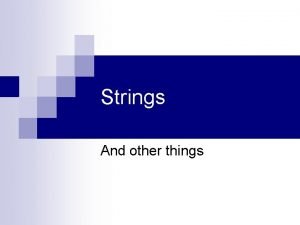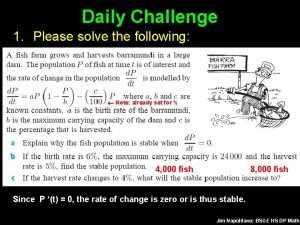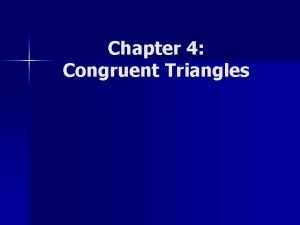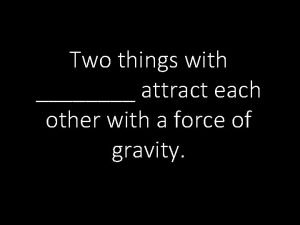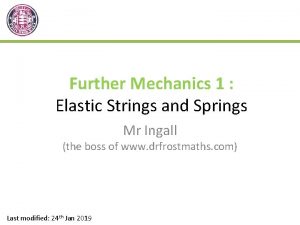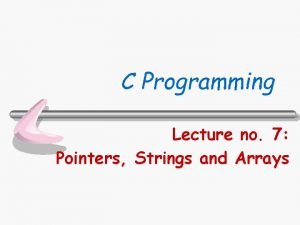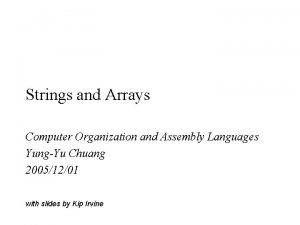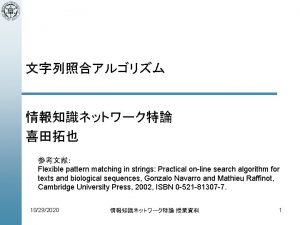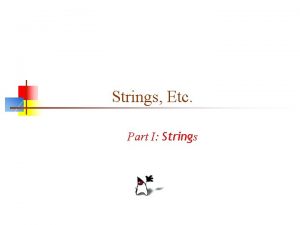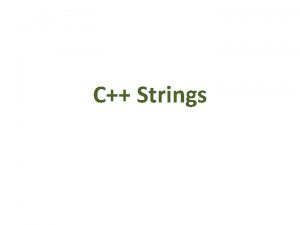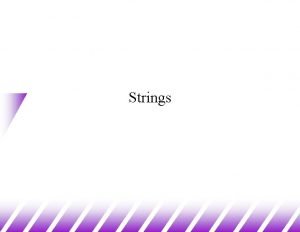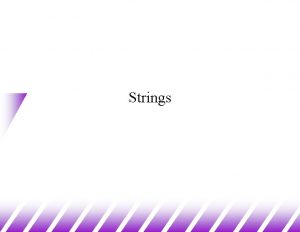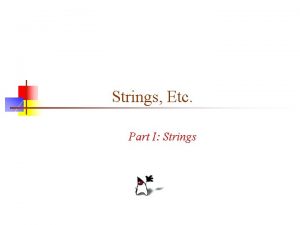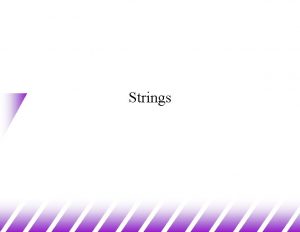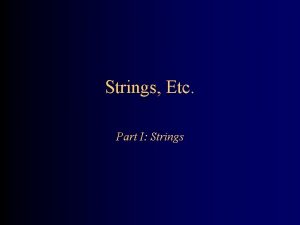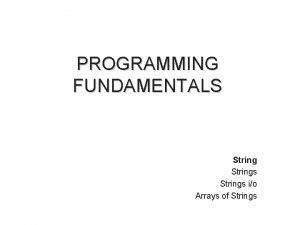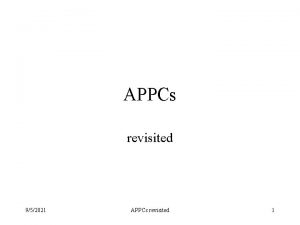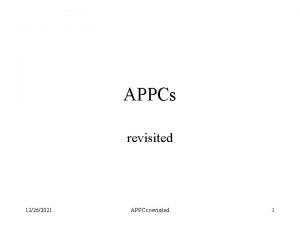Methods on strings and other things Strings revisited




















- Slides: 20

Methods – on strings and other things Strings, revisited Objects and their methods Indexing and slicing Some commonly used string methods

Remember: What is a string? A string is a sequence of zero or more characters A string is delimited (begins and ends) by single or double quotes poem = 'Ode to a Nightingale' lyric = "Roll on, Columbia, roll on" exclamation = "That makes me !#? " The empty string has zero characters ('' or "")

Quote characters in strings You can include a single quote in a double quoted string or a double quote in a single quoted string will = "All the world's a stage" ben = 'BF: "A penny saved is a penny earned"' To put a single quote in a single quoted string, precede it with the backslash ('') or 'escape' character. >>> will = 'All the world's a stage' >>> print(will) All the world's a stage The same goes for double quotes >>> ben = "BF: "A penny saved is a penny earned"" >>> print(ben) BF: "A penny saved is a penny earned"

Putting a format character in a string A format character is interpreted by the print() function to change the layout of text To put a format character in a string, precede it with the backslash ('') A newline is represented by 'n' >>> juliette = 'Good night, good nightn. Parting is such sweet sorrow' >>> print(juliette) Good night, good night Parting is such sweet sorrow A tab is represented by 't' >>> tabs = 'col 0tcol 1tcol 2' >>> print(tabs) col 0 col 1 col 2

Index of string characters The first character of a string has index 0 >>> greeting = 'hello, world' >>> greeting[0] 'h' >>> 'hello, world'[0] 'h' You can also count back from the end of a string, beginning with -1 >>> greeting = 'hello, world' >>> greeting[-1] 'd' >>> 'hello, world'[-1] 'd'

Slicing a string You can use indexes to slice (extract a piece of) a string a. Str[i: j] is the substring that begins with index i and ends with (but does not include) index j >>> greeting = 'hello, world' >>> greeting[1: 3] 'el' >>> greeting[-3: -1] 'rl' omit begin or end to mean 'as far as you can go' >>> print(greeting[: 4], greeting[7: ]) hell world a. Str[i: j: k] is the same, but takes only every k-th character >>> greeting[3: 10: 2] 'l, wr'

Index/slice a string vs index/slice a list How they're the same and how they're different SAME: You can index a list or string by providing an integer index value, beginning with 0 from the left or -1 from the right [i]. You can slice a list or string by providing begin and end values ([i: j]) or begin, end and step values ([i: j: k]) You can omit begin or end ([: j] or [i: ]) to mean 'as far as you can go'

List index vs string index (continued) DIFFERENT: if you reference a single element of a list with the index operator ([i]), its type is the type of that element >>> abc = ['a', 'b', 'c'] >>> abc[0] 'a' >>> type(abc[0]) <class 'str'> If you slice (extract a piece of) a list with begin and end ([i: j]) values, you get a sublist (type list) >>> abc[0: 2] ['a', 'b'] >>> type(abc[0: 2]) <class 'list'>

String methods A method is a function that is bundled together with a particular type of object A string method is a function that works on a string This is the syntax of a method: an. Object. method. Name(parameter. List) For example, >>> 'avocado'. index('a') 0 returns the index of the first 'a' in 'avocado' You can also use a variable of type string >>> fruit = 'avocado' >>> fruit. index('a') 0

Method parameters Like any function, a method has zero or more parameters Even if the parameter list is empty, the method still works on the 'calling' object: >>> 's'. isupper() False Here is a string method that takes two parameters: >>> a. Str = 'my cat is catatonic' >>> a. Str. replace('cat', 'dog') 'my dog is dogatonic'

Strings are immutable A string is immutable -- once created it can not be modified When a string method returns a string, it is a different object; the original string is not changed >>> >>> 'my a. Str = new. Str dog is a. Str cat is 'my cat is catatonic' = a. Str. replace('cat', 'dog') dogatonic' catatonic' However, you can associate the old string name with the new object >>> >>> 'my a. Str = 'my cat is catatonic' a. Str = a. Str. replace('cat', 'dog') a. Str dog is dogatonic'

Python string methods Python has many very useful string methods You should always look for and use an existing string method before coding it again for yourself. Here are some s. capitalize() s. count() s. endswith() / s. startswith() s. find() / s. index() s. format() s. isalpha()/s. isdigit()/s. islower()/s. isspace() s. join() s. lower() / s. upper() s. replace() s. split() s. strip()

The split method The string method split() lets us separate a string into useful parts Common use: splitting a sentence into its words Splits by space characters by default, but you can give it a different 'separator' string >>> s = "Captain, incoming transmission!" >>> print(s. split()) ['Captain, ', 'incoming', 'transmission!'] >>> s = "a one, a two, a one two three four" >>> print(s. split(', ')) ['a one', 'a two', 'a one two three four']

The strip method The string method strip() “cleans” the edges of a string by removing the character(s) you specify (default: spaces) >>> s = "(hello!)" >>> print(s. strip("()!")) hello The string module contains a useful variable for this, called punctuation (like how the math module has pi) >>> import string >>> string. punctuation '!"#$%&'()*+, -. /: ; <=>? @[\]^_`{|}~'

Using split() and strip() together The split method is useful for extracting words, and the strip method is useful for cleaning them up Remember that strip() is a string method, not a list method >>> import string >>> words = ['How', 'are', 'you, ', 'sir? '] >>> print(s. strip(string. punctuation)) Attribute. Error: 'list' object has no attribute 'strip' So, how can we clean up every word in a sentence, once we've split it?

Using split() and strip() together The strip() method works on one “word” at a time So, take it one word at a time >>> import string >>> words = ["It's", 'warm', 'today, ', 'yeah? '] >>> for item in words: print(item. strip(string. punctuation)) It's warm today yeah Side question: why can't we just use the replace() method to get rid of punctuation like this?

Python string method documentation You can find the meaning of each of these string methods in the Python documentation Some operations on strings also work with other sequence types, both mutable and immutable. For example: x in s x not in s s + t s*n / n*s len(s) min(s) max(s)

Strings and the print() function The print() function always prints a string. The input() function always inputs a string. Every object in Python has a string representation. Therefore, every object can be printed. When you print a number, a list or a function it is the string representation of the object that is printed print() takes 0 or more arguments and prints their string representations, separated by spaces >>> print('pi =', 3. 14) pi = 3. 14 >>> def f(): pass >>> print(f) <function f at 0 x 02 C 4 BD 20>

The print separator and end By default, print() separates multiple outputs with spaces You can change this to any string that you want, for example, a colon and a space (': ') >>> print(1, 2, 3, sep=': ') 1: 2: 3 By default, print() ends its output with a newline ('n') >>> for i in range(3): print(i) 0 1 2 You can change this, for example, to a hyphen >>>for i in range(3): print(i, end='-') 0 -1 -2 -

The string format method The string format() method allows you detailed control over what is printed and its arrangement (including alignment; width; your choice of date, time and number formats; and many other things). Here is an example of how s. format() can be used to control what is printed: >>> print('{} is {}'. format('Big Bird', 'yellow')) Big Bird is yellow >>> print('{} is {}'. format('Oscar', 'grumpy')) Oscar is grumpy
 String and other things
String and other things Straight line motion revisited homework
Straight line motion revisited homework Zhuoyue zhao
Zhuoyue zhao Things not strings
Things not strings Direct wax pattern technique
Direct wax pattern technique Venn diagram of living things and nonliving things
Venn diagram of living things and nonliving things Hemoglobin procedure
Hemoglobin procedure 4-1 practice congruent figures
4-1 practice congruent figures Types of positions
Types of positions Things that attract each other
Things that attract each other The law of demand states that holding other things constant
The law of demand states that holding other things constant Ceiiinosssttuu
Ceiiinosssttuu Pointers and strings
Pointers and strings 7 life processes
7 life processes Array of strings assembly
Array of strings assembly Strings in java
Strings in java Image search reverse
Image search reverse Rate of energy transfer by sinusoidal waves on strings
Rate of energy transfer by sinusoidal waves on strings Ascii history
Ascii history Kinaban
Kinaban Michael league bass strings
Michael league bass strings
